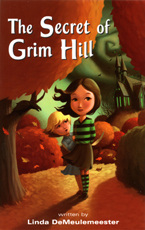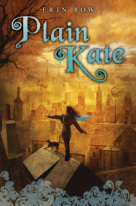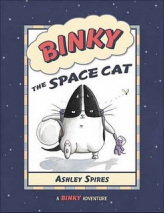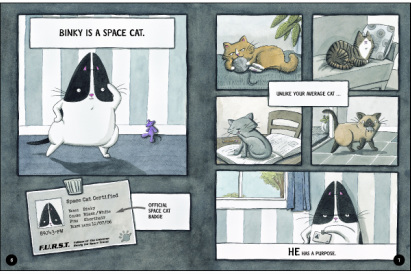
The Secret of Grim Hill by Linda DeMeulemeester
Lobster Press, 2007
Cat and her younger sister, Sookie, have just moved to a new town with their mother, and Cat is not enjoying Darkmont High at all. Soccer-playing Cat soon finds out about soccer scholarships to the nearby private Grimoire school that are earned by the winning team of a Halloween match. Despite continually hearing from Sookie and their neighbour, Jasper, that something just isn't right about Grimoire, Cat goes ahead with her daily team practices until the bizarre events of an early Halloween party change her priorities.
I was spurred to read The Secret of Grim Hill by a new student who wondered if the library had the sequels because he enjoyed this book so much. He reads a lot and very quickly, so I thought if he liked it then it must be pretty good. Happily, it is.
Cat is a realistic tween protagonist: she is easily annoyed by her younger sister, very aware of her school's social hierarchy and endeavours to climb it, fulfills her household responsibilities despite wishing she didn't have to, and is quintessentially likable. When push comes to shove, Cat's priorities are in order (soccer and family at the top with homework dead last). Sookie is as much or even more compelling as a precocious, Monopoly-loving little girl who is generally as seemingly as annoyed with Cat as Cat is with her.
The atmosphere of Grim Hill is generally light with escalating indications to the reader that something dark is afoot. DeMeulemeester's incorporation and explanations of Celtic mythology and traditions are seamlessly done, and the tension builds to a peak that is exhilarating and urgent but not full-on scary. I look forward to reading one or more of the sequels (loaned from another school library for the student mentioned earlier) to see if the Celtic theme is maintained or if other mythologies are incorporated into the series.
Overall, a solid beginning to a middle-grade fantasy series.
Lobster Press, 2007
Cat and her younger sister, Sookie, have just moved to a new town with their mother, and Cat is not enjoying Darkmont High at all. Soccer-playing Cat soon finds out about soccer scholarships to the nearby private Grimoire school that are earned by the winning team of a Halloween match. Despite continually hearing from Sookie and their neighbour, Jasper, that something just isn't right about Grimoire, Cat goes ahead with her daily team practices until the bizarre events of an early Halloween party change her priorities.
I was spurred to read The Secret of Grim Hill by a new student who wondered if the library had the sequels because he enjoyed this book so much. He reads a lot and very quickly, so I thought if he liked it then it must be pretty good. Happily, it is.
Cat is a realistic tween protagonist: she is easily annoyed by her younger sister, very aware of her school's social hierarchy and endeavours to climb it, fulfills her household responsibilities despite wishing she didn't have to, and is quintessentially likable. When push comes to shove, Cat's priorities are in order (soccer and family at the top with homework dead last). Sookie is as much or even more compelling as a precocious, Monopoly-loving little girl who is generally as seemingly as annoyed with Cat as Cat is with her.
The atmosphere of Grim Hill is generally light with escalating indications to the reader that something dark is afoot. DeMeulemeester's incorporation and explanations of Celtic mythology and traditions are seamlessly done, and the tension builds to a peak that is exhilarating and urgent but not full-on scary. I look forward to reading one or more of the sequels (loaned from another school library for the student mentioned earlier) to see if the Celtic theme is maintained or if other mythologies are incorporated into the series.
Overall, a solid beginning to a middle-grade fantasy series.



 RSS Feed
RSS Feed